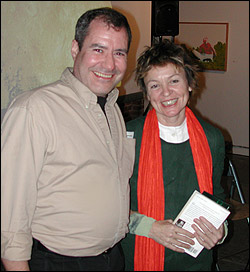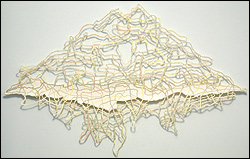After providing three years of stability and growth to a visual arts organization that previously had little of either, Don Hudgins has stepped down as executive director of the Center on Contemporary Art. The parting was generally amicable, but it was clear there were real differences between Hudgins and CoCA’s board of directors over the direction of the organization. For much of its 20-year history, CoCA has been a tenuous enterprise, with board squabbles and a lack of a permanent location topping the list of troubles. Hudgins helped change that.
“When Don first started, CoCA was teetering on the edge of collapse,” says John Gascon, CoCA’s current president, a local architect and visual artist. “We’re as healthy as we’ve ever been now.” CoCA finances are in the black, and the board has been careful, even stingy about hiring staff. Hudgins was the only paid staffer, and according to Gascon, Hudgins was looking for more than CoCA was willing to offer. “He needs a bigger organization,” Gascon says. Hudgins agrees: “I felt this was the best way to move, careerwise. They’re under capacity [in terms of staff], and they need to change that.” Hudgins, who previously worked for four years as Dale Chihuly’s collection manager, is currently in contact with several arts organizations. He’ll also be involved in the Patch Project, a King County project linking visual arts and smoking prevention efforts.
CoCA gained crucial respectability during Hudgin’s tenure. This year’s “Domicile” group show was a focused, high-quality exhibit. CoCA also opened its Northwest Annual to artists outside the region in an effort to bring fresh work to a series with a reputation for recycling local artists. Greg Lundgren’s “101 Ways to Remove a President From Power” exhibit and a recent performance by Laurie Anderson were some of the highlights of the current season. And CoCA’s new space—though it isn’t as prominent as its former Capitol Hill digs—finally offered a chance at stability, something the peripatetic organization has long lacked.
But like most arts organizations, funding remains a huge concern. Hudgins and the board disagreed over whether to bring people with deeper pockets onto the board. “We’re proud to be a working board,” says Gascon, referring to the 12-member board, many of whom are active artists. “It allows us to stay more intimate with what’s going on in the arts community.”
Hudgins, however is less sanguine about the artist-heavy board. “I don’t see how they’re going to succeed,” he says, implying that CoCA needs to attract heavy-hitting fund-raisers. “Funding has always been a struggle for CoCA,” says Hudgins, “and I think it will continue to be.”







